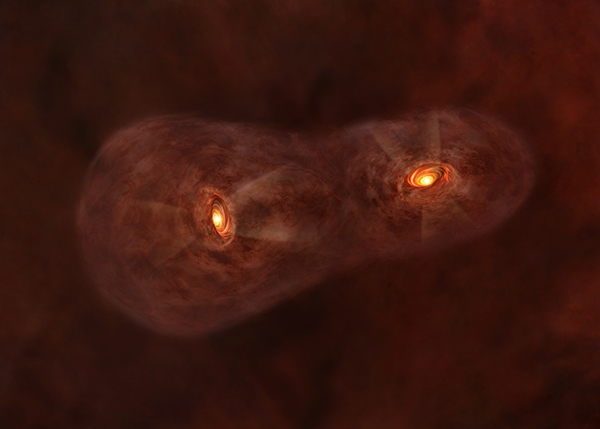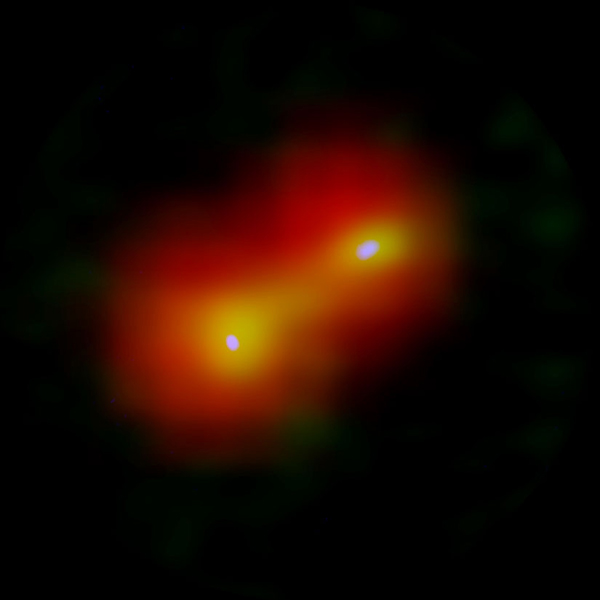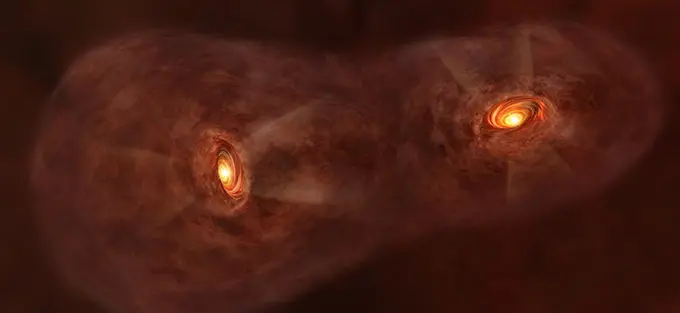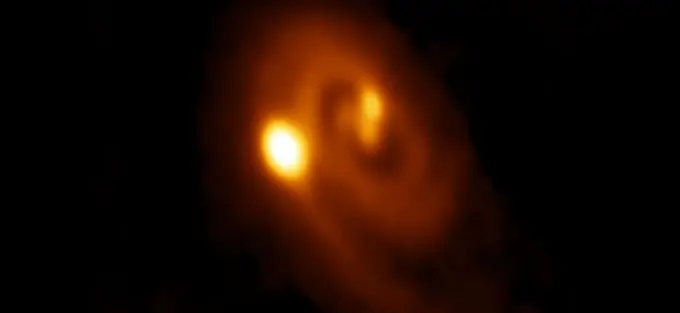ALMA Reveals Turbulent Birth of Twin Baby Stars
30 June, 2017 / Read time: 5 minutes
ALMA Kids PublicationUsing the Atacama Large Millimeter/submillimeter Array (ALMA), researchers obtained a critical clue to an underlying problem: how are widely separated twin stars formed? The team found very low mass newborn twin stars with misaligned rotation axes. This misalignment indicates that they were formed in a pair of fragmented gas clouds produced through turbulence, not via evolution of tightly-coupled twin. This finding strongly supports the turbulent fragmentation theory of binary star formation down to the substellar regime.
An international team of astronomers led by Jeong-Eun Lee in Kyung Hee University, Korea, observed the baby twin star system IRAS 04191+1523 with ALMA. Thanks to the high resolution of ALMA, the team successfully imaged the rotation of the gas disks around the very low mass twin stars and found that the rotation axes of the two stars are misaligned.
“This revelation is particularly interesting because both baby stars’ masses derived from our ALMA data are about 10% of the solar mass, which is very low. The formation of very low mass wide binary stars has been a mystery. But our result is strong evidence that wide binaries of these very low mass stars and even brown dwarfs can form in the same way as normal stars via turbulent fragmentation.” said Lee.
More than a half of the stars in the Universe are born as twins or multiple systems. Therefore, unveiling the formation mechanism of twin stars is crucial for a comprehensive understanding of stellar evolution.

There are two types of multiple stars: close systems and widely separated systems. Astronomers have witnessed a close system being formed via fragmentation of the gas disk around the firstborn stars [1]. On the other hand, there is no clear evidence on how widely separated systems are formed. Some researchers assume that a close system evolves into a wide system over millions of years due to dynamical interactions, but others guess that turbulence in a gas cloud fragments the cloud into smaller ones and stars are formed in each small cloud.
Aiming to find clues to the formation of wide binary systems, the researchers selected IRAS 04191+1523 as the target of their ALMA observations. The separation of the two stars is about 30 times the distance of Neptune from the Sun and classified as a wide binary. The age of the system is estimated to be far younger than half a million years old, therefore it is a good target to investigate the initial phase of wide binary formation.

The team analyzed the signal from carbon monoxide molecules in the disks to derive their motion and found that the two disks around the baby stars are not aligned. The angle between the rotation axes of the disks is 77 degrees.
“The system is too young for the alignment of axes to have been modified by interactions,” said Lee [2], “so we conclude that this system was formed by the turbulent fragmentation of a cloud, not by disk fragmentation and migration.”
If a binary system is formed via disk fragmentation, the rotational moment of the gas aligns the axes of two stars. This alignment would be maintained even if the separation between the two is extended via tidal interactions. The misalignment of the axes in the infant system IRAS 04191+1523 clearly rejects this scenario.
Notes
ALMA revealed the detailed structure of the ongoing fragmentation of a gas disk around a young triple star system L1448 IRS 3B.
Previous ALMA observations of a young binary system HK Tauri show that the two disks are misaligned. However, HK Tauri is much more evolved than IRAS 04191+1523 and it is difficult to reject the possibility of orbit evolution to become a widely-separated system.
Additional information
These observation results were published as Lee et al. “Formation of Wide Binaries by Turbulent Fragmentation” in Nature Astronomy on June 30, 2017.
The research team members are:
Jeong-Eun Lee (Kyung Hee University), Seokho Lee (Kyung Hee University), Michel Dunham (State University of New York at Fredonia), Ken’ichi Tatematsu (National Astronomical Observatory of Japan / SOKENDAI), Minho Choi (Korea Astronomy and Space Science Institute), Edwin A. Bergin (University of Michigan), Neal J. Evans II (Korea Astronomy and Space Science Institute / The University of Texas at Austin)
This research was supported by the Basic Science Research Program through the National Research Foundation of Korea (NRF) (grant No. NRF-2015R1A2A2A01004769) and the Korea Astronomy and Space Science Institute under the R&D program (Project No. 2015-1-320-18) supervised by the Ministry of Science, ICT and Future Planning, Korea.
The Atacama Large Millimeter/submillimeter Array (ALMA), an international astronomy facility, is a partnership of the European Organisation for Astronomical Research in the Southern Hemisphere (ESO), the U.S. National Science Foundation (NSF) and the National Institutes of Natural Sciences (NINS) of Japan in cooperation with the Republic of Chile. ALMA is funded by ESO on behalf of its Member States, by NSF in cooperation with the National Research Council of Canada (NRC) and the Ministry of Science and Technology (MOST) in Taiwan and by NINS in cooperation with the Academia Sinica (AS) in Taiwan and the Korea Astronomy and Space Science Institute (KASI).
ALMA construction and operations are led by ESO on behalf of its Member States; by the National Radio Astronomy Observatory (NRAO), managed by Associated Universities, Inc. (AUI), on behalf of North America; and by the National Astronomical Observatory of Japan (NAOJ) on behalf of East Asia. The Joint ALMA Observatory (JAO) provides the unified leadership and management of the construction, commissioning and operation of ALMA.
Contacts
-
Nicolás Lira
Education and Public Outreach Coordinator
Joint ALMA Observatory, Santiago - Chile
Phone: +56 2 2467 6519
Cel: +56 9 9445 7726
Email: [email protected]
-
Masaaki Hiramatsu
Education and Public Outreach Officer, NAOJ Chile
Observatory, Tokyo - Japan
Phone: +81 422 34 3630
Email: [email protected]
-
Richard Hook
Public Information Officer, ESO
Garching bei München, Germany
Phone: +49 89 3200 6655
Cel: +49 151 1537 3591
Email: [email protected]
-
Charles E. Blue
Public Information Officer
National Radio Astronomy Observatory Charlottesville, Virginia - USA
Phone: +1 434 296 0314
Cel: +1 202 236 6324
Email: [email protected]


